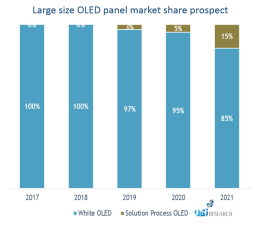UBI Research has released a forecast that suggests that solution-processed OLEDs will be used for 3% of all OLED TVs by 2019, rising to 15% by 2021, with the balance being made using WOLED and colour filters. The company points out that solution-processed materials are much less developed than the evaporation materials used for WOLED and that is a challenge for solution processing.

Analyst Comment
Solution processing with inkjet deposition has long been the aim of OLED makers and has been under development for many years without getting to volume production. Materials remain weak, compared to evaporated materials, especially the blue. It has also been difficult to get uniformity good enough – although the smaller pixels of current displays mean that the problems of unevenness within single pixels is likely to be less of an issue than in the past. We have also heard that there can be issues of different layers of soluble materials reacting with each other.
On the other hand, getting this to work (and JOLED is threatening to introduce it in production (JOLED Plans 21.6″ UHD OLED Production)) would really boost the possibilities of OLED competing in the TV mainstream. And Kateeva, which has done a lot on ink jet encapsulation, is confident it can do it soon. (BC15 Kateeva May Enable Printing of OLEDs) (BR)

